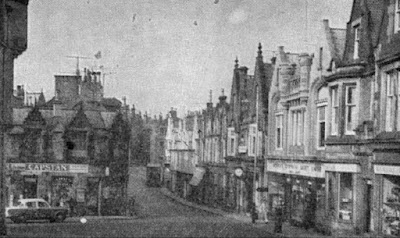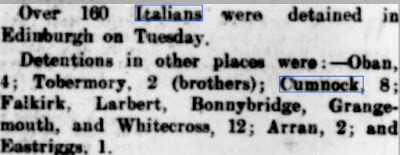By Kay McMeekin
John Caddies on the Cumnock Connections family tree. See the article towards the end for his experiences in his own words.
David Murdoch and his son in law John Caddies sailed on the Austral from London to Sydney on the 22nd February 1889. They soon found work in the mining town of Minmi, New South Wales and sent for their wives and children. They paid their deposit in March 1889.
The extended family of Murdoch/Fleming/Caddies sailed on the Cuzco arriving in Sydney on 6th August 1889.
They moved to Cessnock and David Murdoch junior became under manager at Aberdare Colliery. David Murdoch senior returned to Scotland at some point where he died in 1899 in the Poorhouse Ayr of "cardiac" aged 62 a stone breaker, husband of Elizabeth Fleming. The death certificate was signed by the Governor and his usual address was Dalrymple. Not found his passage home or any sign of him in Dalrymple. The poorhouse served as a hospital.
His wife Elizabeth Fleming was born in Beith about 1843. They married in Cumnock in 1863, and they had 8 children between then and 1881.
Their daughter Elizabeth Murdoch married John Caddies in 1887.
John Caddies lived into his nineties.
The following article was found on the website trove. John (Jock) Caddis is over 86 years of age. His recipe for a long life is:
STICK TO THE FOOTPATHS
Jock estimates that during his lifetime he has walked from Australia to Scotland four times and is somewhere near Colombo on the fifth trip. Born on February 10, 1864, at Kilmarnock, just two miles from the famous Cessnock Castle, from which the town of Cessnock (N.S.W.) takes its name, it was only natural for Jock to select Cessnock as the place to end his days. He came to Cessnock 45 years ago. Jock's first occupation was at the coal face at a very early age. In those days a miner usually took a lad into the mine in order to qualify for a double turn of tubs. John Caddis, when 22 years of age, married Miss Elisabeth Murdock at Cumnock (Scotland), and two years later sailed for Australia in the s.s. 'Austral' which, at that time was considered one of the fastest liners afloat. She was considered a large vessel, being over 4,000 tons. The 'Austral' caused quite a stir as she steamed through the Sydney Heads and still a greater stir when 14 days later she sank at her moorings. It was believed at the time that none of the crew wanted the return journey. They had heard about fabulously rich gold strikes. The captain refused to pay off the crew. It would appear that at least some of the crew became obsessed with the idea — no ship — no return voyage. Anyway, one night the seacocks were opened and the 'Austral' sank*.
AUSTRALIA FOR JOCK. Jock secured employment as a miner on the South Coast and, while he liked the scenery, he didn't like the pay, so after a couple of months he heard about the mining boom town of Minmi, and after a few weeks work, he decided to send for his wife. Jock must have sent home a most glowing and pleasing account of Australia, and perhaps Minmi in particular, because the Murdoch family decided it was a better place than Scotland and accompanied their sister (Mrs. Caddis) to Australia. When the ship on which they travel-led arrived at Sydney, the captain was advised by the ship's agents to keep the Murdock family on board, pending arrangements for their transportation to Minmi, where they were given employment. The Murdocks soon made their name prominent, as most of the menfolk became colliery officials in the coalmining industry.
THE MINMI RANGERS Jock Caddis was one of the footballers to leave Scotland and he soon found a place in the famous Minmi Rangers, then the soccer (or British, as it was called in those days) champions of the Common- wealth. For two years this famous team never lost a game nor had a goal scored against them. Despite the number of trophies Jock won, the only medal that dangles from his watch chain is the medal won in 1888, when the Minmi Rangers won the Common- wealth championship. Out of that famous team it is believed that only five survive. Of these, Tom Campbell, Jock Caddis, Frank Leckie and Bob Harden (the team baby), live at Cessnock, whilst Jock McCartney is at present accompanying his daughter, Miss Nellie McCartney, the world famous pianiste, on her present Australian tour. All are either 80 years of age or, near 90 years.
A MILLER'S GUIDE After Jock finished playing as a football star, he took a keen interest in all sports, from a quoit match to the Melbourne Cup. He soon became the selected auth-ority or umpire, whose decision settled all arguments. One had only to ask Jock what horse won the Newmarket in 1900 and he would quote the name of the horse, its breeding, and weight carried, who owned it, who rode it, the colours and the time taken to run the distance. It was the same with fighters, foot runners, etc. Yes, Jock was a Miller's Guide.
FOOTPATHS Jock is so well known throughout the North that any person admitting no knowing Jock Caddis is immediately tagged a New Australian or Balt. Quite a lot of people believe that Jock is the General Superintendent of footpaths for the Municipal Council of Cessnock. He may have been, but for the past 12 years Jock has been in charge of Vincent Street. His beat consists of six trips (both ways) from the Railway Station to Conway's Corner. Recently, Jock inquired from Rover Motors when the next bus went to Belllird. He was informed by the man in charge, after consulting his watch, 'In 35 minutes time.' Jock replied, 'I'll not wait, I'll walk out and catch it coming back.' Jock recommends that any man can cure insomnia by walking a mere 12 miles a day, providing, of course, that he is over 80 years of age. Jock says that there is only one person killed each year in Australia on a footpath and the death is the result of a brawl. Thousands are killed on the streets and roads. Jock's only message, on the occasion of his birthday, is — 'Stick to the footpaths and live. Walk the streets and die.'
APA citation
STICK TO THE FOOTPATHS (1950, April 6). The Cessnock Eagle and South Maitland Recorder (NSW : 1913 - 1954), p. 7. Retrieved February 20, 2025, from http://nla.gov.au/nla.news-article103583121
THE STEAMSHIP AUSTRAL
*The Austral was scuppered in November 1882, but it was raised in February 1883 and put back into service.
Raising the Austral. (1883, February 10). Australian Town and Country Journal (Sydney, NSW : 1870 - 1919), p. 32. Retrieved February 21, 2025, from http://nla.gov.au/nla.news-article70995949\
The footballer mentioned in the article Jock McCartney is also an Ayrshire man from Cronberry. He came out in 1887, his younger brother David in 1910. David was a retired professional footballer and went back to mining in South Aberdare.
 |
| John McCartney with daughters Nellie, left, the pianist and Hilda |
Nellie took the stage name Nan Kenway when she changed from being a pianist to a comedy actress.












